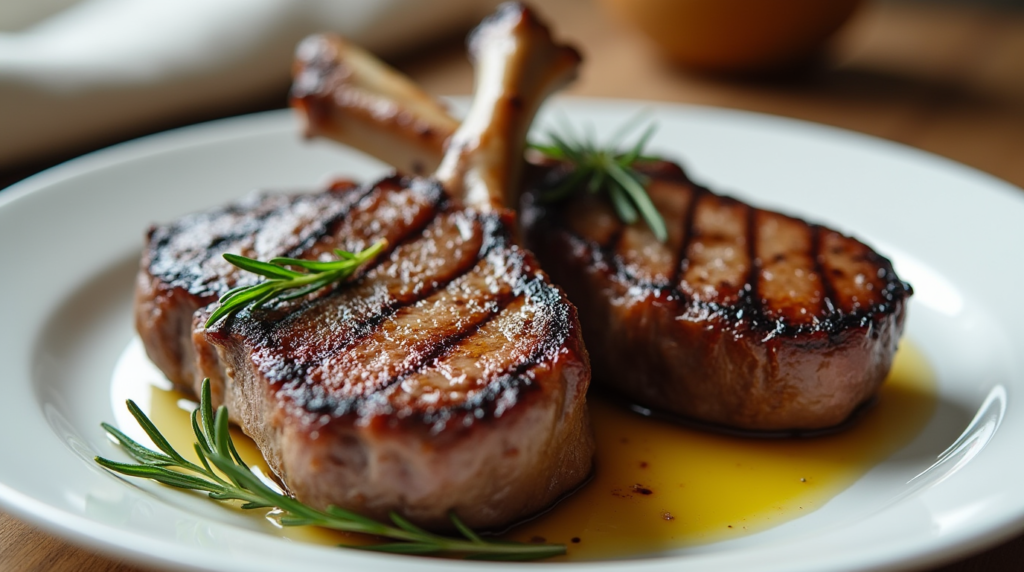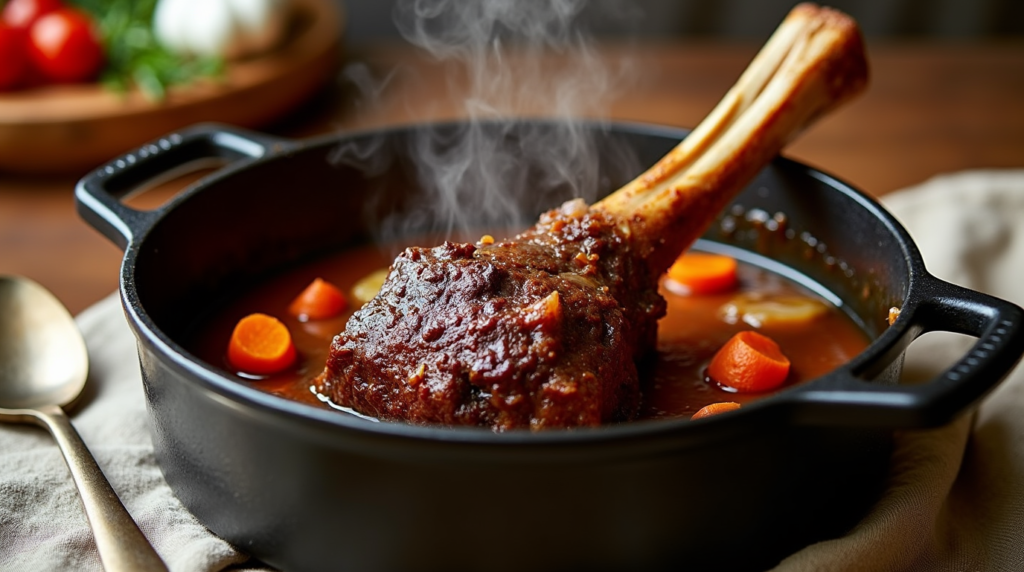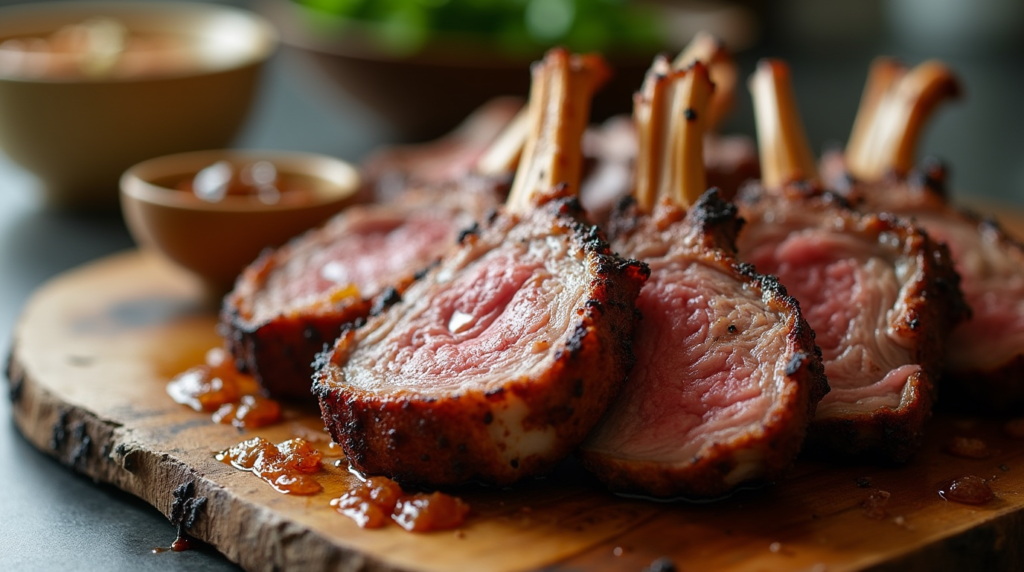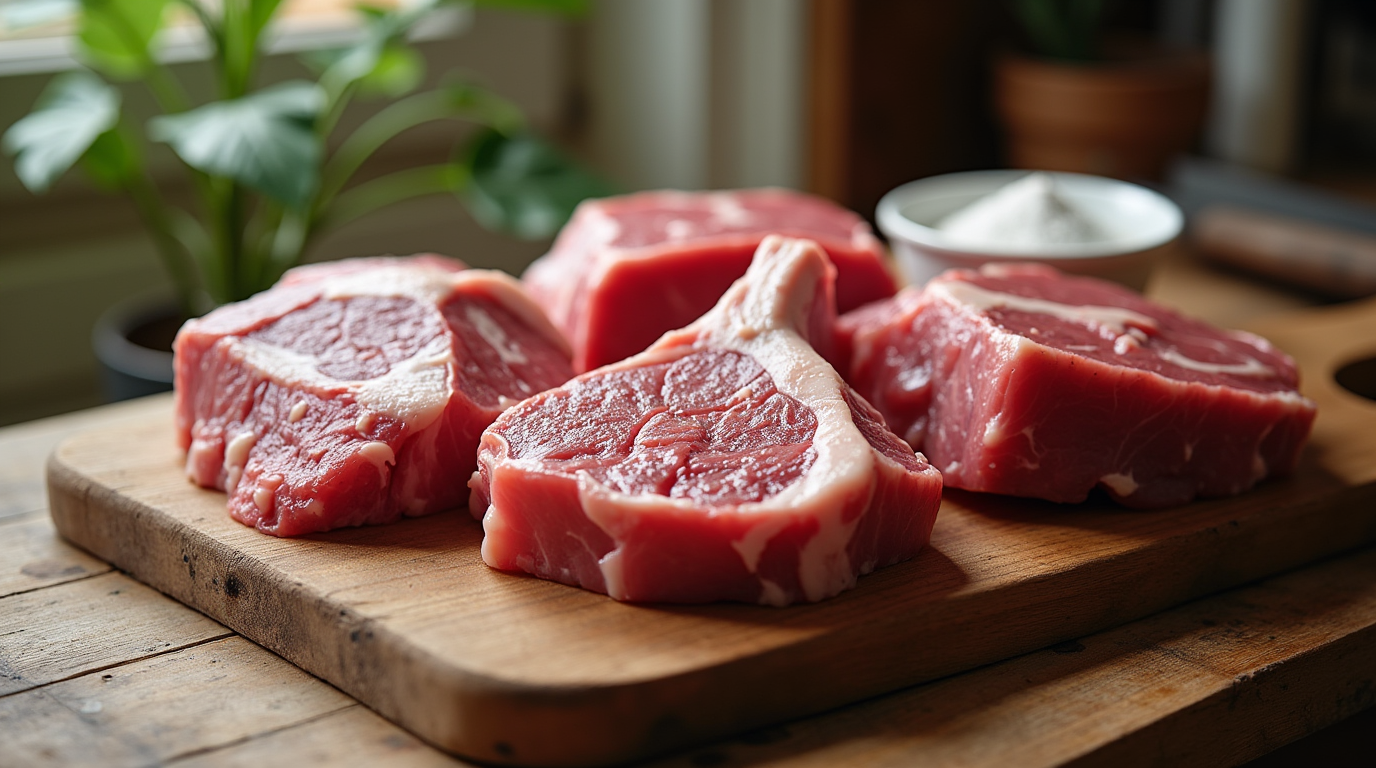Cooking lamb well means choosing the right method to match the cut and taste you want. Options like roasting, grilling, slow-cooking, and air-frying each bring out different flavors and textures.
For example, slow-cooking works well for soft, tender meat, while air-frying creates a crispy outside. The cooking method you pick can make your lamb dish taste even better.
Understanding Lamb Cuts
Overview of Different Cuts of Lamb
Lamb offers several cuts, each with its unique flavor and texture. For example, the shoulder is rich and works best for slow cooking. In contrast, the leg is leaner, making it perfect for roasting. Additionally, the rack and loin are tender and ideal for quick cooking methods like grilling or air frying. Meanwhile, the shank has more connective tissue, which makes it suitable for braising, as the slow cooking process breaks it down.
Best Cuts for Various Cooking Methods
Different cooking methods match better with specific lamb cuts. For instance, roasting suits the leg and shoulder because of their size and rich flavor. Similarly, grilling or pan-searing is perfect for the rack and chops, as these methods provide a crispy exterior while keeping the meat tender. On the other hand, tougher cuts like the shank need slow cooking methods, such as braising, to become tender. Furthermore, you can butterfly the loin for grilling or leave it whole for a simple roast. Therefore, choosing the right cut ensures the best results for your chosen cooking style.
Factors to Consider When Choosing a Cooking Method
Flavor Profile
The cooking method you choose can have a significant impact on the flavor of lamb. Roasting and grilling, for example, enhance the natural flavors, giving the meat a rich, caramelized taste. On the other hand, slow cooking or braising infuses the lamb with additional flavors from herbs, spices, and liquids. Therefore, when selecting your cooking method, consider the flavor you want to achieve: roasting will provide a deeper, more intense flavor, while grilling gives a smoky profile.
Texture Preferences
The texture of lamb changes based on the cooking technique. Roasting and grilling offer tender meat with slightly crispy exteriors, whereas slow-cooking methods like braising or stewing create a melt-in-your-mouth experience. If you prefer a softer bite, slow roasting or braising may be ideal, while grilling or pan-searing will result in a firmer texture.
Cooking Time
Cooking time is another key factor to consider. Quick methods like grilling or pan-searing allow you to prepare a meal in under an hour, whereas slow cooking or braising requires more time but results in tender, flavorful lamb. If you’re in a hurry, quicker techniques are your best bet; however, for special occasions, slow-cooked methods are worth the extra time.
Occasion and Presentation
Finally, the occasion and desired presentation should influence your choice of cooking method. For a formal dinner, a beautifully presented rack of lamb, perfectly roasted and carved at the table, is a great choice. Meanwhile, a casual family meal might be better suited to a hearty braise or stew. If you’re aiming for a stunning visual presentation, roasting or grilling is the way to go, while slow-cooked lamb has a more rustic and comforting appeal.
Grilling Lamb
Ideal Cuts for Grilling
Grilling is perfect for tender cuts of lamb that cook quickly and can be charred on the outside while staying juicy on the inside. The best cuts for grilling include:
- Lamb Chops: Bone-in chops, like loin or rib chops, are a classic choice, offering great flavor and tenderness.
- Rack of Lamb: When grilled, a rack of lamb can create an impressive presentation with a beautiful crust.
- Lamb Steaks: These thick cuts, usually from the leg or shoulder, can be grilled to your preferred level of doneness.
Techniques for Perfectly Grilled Lamb
To grill lamb perfectly, follow these tips:
- Preheat the Grill: Ensure your grill is at medium-high heat before placing the lamb on it.
- Seasoning: Season lamb with olive oil, salt, pepper, and your favorite herbs or marinades for extra flavor.
- Indirect Heat: For thicker cuts like lamb steaks or racks, start by searing the lamb on direct heat for a few minutes on each side. Then, move it to indirect heat to cook through without burning.
- Resting Time: After grilling, let the lamb rest for a few minutes before serving to allow the juices to redistribute.
Common Grilling Mistakes
- Overcooking: Lamb is best cooked to medium-rare or medium. Overcooking can make it dry and tough.
- Not Resting the Meat: Cutting into lamb immediately after grilling lets the juices escape, leaving the meat dry. Always rest the meat.
- Using Too Much Marinade: While marinating adds flavor, excess marinade can cause flare-ups or uneven grilling.
- Inconsistent Grill Temperature: Fluctuating grill temperatures can lead to uneven cooking. Make sure your grill maintains a steady heat throughout the grilling process.

Roasting Lamb
Lamb Chops vs. Roasting Whole Lamb
Roasting lamb is an excellent method for cooking larger cuts, offering a tender and flavorful result. However, there are key differences between roasting a whole lamb and roasting individual lamb chops:
Whole Lamb (Leg or Rack): Roasting a whole leg or rack of lamb presents a dramatic visual appeal, making it perfect for special occasions. The meat becomes tender and juicy, and you can serve it as a large roast, ideal for feeding multiple guests.
Lamb Chops: On the other hand, roasting lamb chops is quicker and provides more control over the level of doneness. This method works well for smaller gatherings, offering the advantage of a crispy exterior with a tender interior.
Herbs and Seasonings for Roasting
To elevate the flavor of your roasted lamb, consider using these delicious herbs and seasonings:
Rosemary and Garlic: These two classic ingredients pair wonderfully with lamb, with rosemary adding fragrance and garlic contributing depth to the flavor.
Thyme and Mint: Fresh thyme and mint offer a refreshing contrast to the richness of lamb, making them excellent choices for seasoning.
Lemon Zest and Dijon Mustard: The combination of citrus zest and mustard adds a tangy kick, brightening up the overall flavor of your roast.
Spices: To create a Middle Eastern or Mediterranean flavor profile, cumin, coriander, and paprika are perfect additions to your lamb seasoning.
Temperature and Timing Guide
For a perfectly roasted lamb, follow these general guidelines to ensure success:
Temperature: Preheat your oven to 375°F (190°C) before roasting.
Roasting Time for Whole Leg: A bone-in leg of lamb should be roasted for about 20 minutes per pound for medium-rare (internal temperature of 130-135°F).
Roasting Time for Lamb Chops: Roasting lamb chops typically takes around 10-15 minutes at 375°F, depending on the thickness and desired doneness.
Resting: After removing the lamb from the oven, allow it to rest for 10-15 minutes before carving to preserve its juices and enhance the flavor.
By following these tips, you’ll ensure a beautifully roasted lamb, whether you opt for a whole roast or lamb chops.
Braising Lamb
What is Braising?
Braising is a slow-cooking method that involves cooking meat at low temperatures in a small amount of liquid. First, you sear the meat to develop flavor, then cook it slowly in a covered pot or Dutch oven. This method is ideal for tougher cuts of lamb, as the long cooking time helps them break down, becoming tender and full of flavor. Braising is perfect for creating melt-in-your-mouth tenderness, especially in tougher cuts of lamb.
Cuts Best Suited for Braising
Certain cuts of lamb are particularly well-suited for braising due to their higher amounts of connective tissue and fat, which break down during slow cooking, adding both flavor and tenderness. The best cuts for braising include:
- Lamb Shanks: Rich in flavor, lamb shanks become wonderfully tender after long, slow cooking.
- Lamb Shoulder: This cut is not only flavorful but also becomes incredibly tender when cooked slowly.
- Lamb Neck: Though often overlooked, lamb neck offers rich flavor and turns very tender when braised.
- Lamb Breast: Though fattier, lamb breast becomes deliciously tender and flavorful when braised.
How to Achieve Tender Braised Lamb
To braise lamb successfully and achieve tenderness, follow these simple steps:
- Sear the Meat: Start by searing the lamb in a hot pan with a little oil. This step helps develop a rich, browned exterior, enhancing the flavor.
- Add Aromatics and Liquid: After searing, remove the lamb and add aromatics like onions, garlic, and herbs (rosemary and thyme are great choices) to the pan. Then, pour in liquid such as stock, wine, or a combination, ensuring the lamb is partially submerged.
- Slow Cook: Return the lamb to the pot, cover it, and let it simmer over low heat. You can cook it on the stovetop or place it in the oven at around 300°F (150°C).
- Cook Low and Slow: Allow the lamb to braise for 2-3 hours, depending on the size and cut. The lamb will be ready when it becomes fork-tender and easily pulls apart.
- Rest Before Serving: Let the lamb rest before serving to retain its juices.
By braising lamb, you can create a deeply flavorful and tender dish, perfect for hearty meals. This method is especially ideal for colder weather and makes for an impressive and satisfying dish to enjoy with friends and family.

Slow Cooking Lamb
Advantages of Slow Cooking
Slow cooking lamb offers numerous benefits. Notably, it’s perfect for tenderizing tougher cuts while allowing the flavors to fully develop. Moreover, the low and slow cooking process helps break down the connective tissue in tougher cuts, making the meat incredibly tender and juicy. Additionally, slow cooking allows the flavors of herbs, spices, and liquids to deeply infuse the meat, creating a rich and savory dish. It’s also incredibly convenient, as it requires little attention once the lamb is set to cook
Recipes for Slow-Cooked Lamb
- Slow-Cooked Lamb Shoulder: This cut is ideal for slow cooking. Typically, the lamb is seasoned with garlic, rosemary, and thyme before being cooked low and slow in a broth or wine-based sauce. As a result, it becomes melt-in-your-mouth tender.
- Lamb Stew: For a hearty dish, chunks of lamb shoulder or neck are braised in a rich, flavorful broth with vegetables and herbs. This creates a comforting stew perfect for colder weather.
- Slow-Cooked Lamb Shanks: Lamb shanks become exceptionally tender when cooked in a slow cooker with onions, garlic, carrots, and wine. The result is a deeply flavored dish, rich in taste.
Tips for Maximum Flavor
- Season Generously: Use herbs like rosemary, thyme, or oregano and spices such as cumin or coriander to complement the flavor of lamb.
- Brown the Meat: To enhance the flavor, consider browning the lamb before slow cooking.
- Use Liquid Wisely: Ensure the lamb remains moist and flavorful by using broth, wine, or even tomatoes as a cooking liquid.
Pan-Seared Lamb
Techniques for a Perfect Sear
To achieve a perfect sear on lamb, ensure the meat is at room temperature before cooking. Start by preheating the pan over medium-high heat and adding a small amount of oil. Once the pan is hot, place the lamb in the pan, and don’t move it for 2-3 minutes to allow a rich crust to form. Flip it to sear all sides evenly. For lamb chops, a quick 2-3 minute sear on each side will create the perfect exterior with a tender, juicy interior.
Best Cuts for Pan-Searing
- Lamb Chops: Ideal for pan-searing due to their small size and tender meat.
- Lamb Loin: A great choice for pan-searing, the tender lamb loin cooks quickly to develop a golden, flavorful crust.
- Lamb Racks (Individual Chops): When seared individually, rack of lamb chops have a crispy crust while retaining a juicy interior.
Achieving Restaurant-Quality Lamb at Home
- Rest Before Serving: After pan-searing, let the lamb rest for a few minutes to ensure the juices redistribute, ensuring a tender bite.
- Finish in the Oven: For thicker cuts like lamb racks or loins, sear them first, then finish cooking them in the oven at around 375°F (190°C) until they reach your desired doneness.
Sous Vide Lamb
Why Choose Sous Vide?
Sous vide cooking offers precise control over the temperature, ensuring the lamb is perfectly cooked every time. This technique allows the meat to cook in its juices, enhancing both flavor and tenderness. Since the lamb cooks slowly and evenly, it prevents overcooking, guaranteeing a consistently tender texture throughout.
Step-by-Step Instructions
- Prepare the Lamb: Season your lamb with your choice of herbs and spices, then place it in a vacuum-seal or Ziploc bag.
- Sous Vide Cooking: Set the sous vide machine to the desired temperature (typically 130°F/54°C for medium-rare or 140°F/60°C for medium) and cook for 1.5 to 4 hours, depending on the cut.
- Finishing: After sous vide cooking, sear the lamb quickly in a hot pan for 1-2 minutes on each side to develop a rich, golden crust.
Finishing Touches for Sous Vide Lamb
For an extra layer of flavor, consider adding a quick glaze or sauce after sous vide cooking. Options like a balsamic reduction, herb butter, or garlic-mint sauce pair wonderfully with sous vide lamb, enhancing its taste and presentation.
Smoking Lamb
Best Cuts for Smoking
Smoking lamb enhances its rich, deep flavors and is especially ideal for tougher cuts that benefit from long, slow cooking.
- Lamb Shoulder: This cut is perfect for smoking, as it becomes tender and flavorful after several hours of slow cooking.
- Lamb Ribs: Lamb ribs are excellent for smoking, developing a delicious smoky crust.
- Lamb Shanks: This cut is great for smoking, producing tender, juicy meat when cooked slowly.
Choosing the Right Wood Chips
The choice of wood chips significantly impacts the flavor of smoked lamb.
- Hickory: This wood provides a strong, hearty flavor that pairs perfectly with the natural richness of lamb.
- Applewood: Lighter and sweeter, applewood adds a mild smokiness that complements lamb without overpowering it.
- Mesquite: A bolder choice, mesquite offers a more intense smoky flavor, making it great for hearty cuts like lamb shoulder.
Enhancing Flavor Through Smoking
- Marinades and Rubs: Before smoking, season lamb with a mix of herbs, garlic, olive oil, and spices like cumin, rosemary, or paprika to elevate its flavor.
- Basting: While smoking, baste the lamb occasionally with a marinade or sauce. This not only keeps the lamb moist but also infuses additional flavors.
Boiling and Poaching Lamb
Differences Between Boiling and Poaching
- Boiling: Involves cooking lamb in rapidly boiling water, typically used for tougher cuts like lamb neck or stew meat. Although it softens the texture, some flavor is lost in the water.
- Poaching: A gentler method, poaching involves cooking lamb in simmering (not boiling) water or broth. This method retains moisture and flavor, making it ideal for delicate cuts like lamb chops or lamb loin.
Recipes for Poached Lamb Dishes
- Poached Lamb Chops: Gently simmer lamb chops in seasoned broth with herbs like rosemary and thyme for a tender, juicy result.
- Lamb in Broth: Poaching lamb in flavorful broth creates a rich, comforting dish, perfect for pairing with vegetables or grains.
When to Use This Method
Both boiling and poaching are excellent for tenderizing tougher cuts, like shanks and stew meat, while keeping the meat moist. Poaching is especially recommended when you want to preserve the delicate flavors of the lamb.
Lamb in the Air Fryer
Benefits of Air Frying Lamb
Air frying lamb offers a quick and convenient way to achieve crispy, flavorful results with less oil. The air fryer circulates hot air around the lamb, ensuring even cooking and creating a golden, crispy exterior while keeping the inside juicy and tender. Additionally, air frying is a healthier option compared to deep frying or pan-frying.
Recipes for Air-Fried Lamb
- Air-Fried Lamb Chops: These lamb chops, seasoned with rosemary, garlic, and olive oil, cook quickly in the air fryer, resulting in a perfectly crispy exterior.
- Air-Fried Lamb Racks: Coat the rack of lamb with a herb crust and cook it in the air fryer for a beautifully crisp outside and tender inside.
- Lamb Meatballs: Air-fried lamb meatballs are a flavorful and healthier alternative to frying, ideal for serving with dips or as a main dish.
Tips for Optimal Results
- Preheat the Air Fryer: Always preheat your air fryer to ensure even cooking.
- Use a Light Coating of Oil: Lightly coat the lamb with olive oil or cooking spray to achieve a crispier texture.
- Avoid Overcrowding: Ensure there’s enough space between pieces of lamb in the basket so the air can circulate properly, ensuring even cooking.

Nutritional Benefits of Different Cooking Methods
Retaining Nutrients Through Cooking
Different cooking methods can impact the nutritional content of lamb in various ways. For instance, grilling, roasting, and air frying generally preserve more nutrients compared to high-temperature methods like frying. Grilling and roasting, in particular, help to retain the lamb’s natural juices, ensuring that essential vitamins and minerals remain intact. Similarly, cooking at lower temperatures, such as in braising or slow cooking, can help retain more water-soluble vitamins, like B vitamins, which are often lost in high-heat cooking methods.
Healthier Options for Lamb Preparation
Certain cooking methods can make lamb healthier, depending on how they are done.
- Grilling and Roasting: These methods allow excess fat to drip off the meat, resulting in a leaner cut.
- Air Frying: Since air frying requires little to no oil, it reduces the fat content while still achieving a crispy, flavorful exterior.
- Slow Cooking and Braising: These techniques allow the lamb to become tender without adding extra fats or oils. For a healthier option, you can use leaner cuts of lamb and pair them with vegetables to boost the nutritional value of the dish.
By opting for these methods, you can enjoy lamb with fewer added fats while retaining more nutrients, making it a balanced and health-conscious choice for your meals.
FAQs About What Cooking Method Is Best For Lamb
How Do You Know When Lamb Is Done?
Use a meat thermometer. For medium-rare, the internal temperature should reach 125-130°F (52-54°C); for medium, aim for 135-140°F (57-60°C).
Can Lamb Be Cooked Rare?
Yes, lamb can be cooked rare. The internal temperature should be around 120°F (49°C) for a tender, juicy result.
What’s the Best Way to Marinate Lamb?
Marinate lamb for 2-4 hours in a mixture of olive oil, garlic, herbs, and spices to enhance flavor and tenderness.
Conclusion
the best cooking method for lamb depends on your preferences for flavor, texture, and time. Grilling and roasting provide rich flavors, while braising and slow cooking offer tenderness. Air frying and sous vide are convenient, delivering great results with less effort. Each method enhances lamb’s unique qualities, making it versatile for any occasion.

